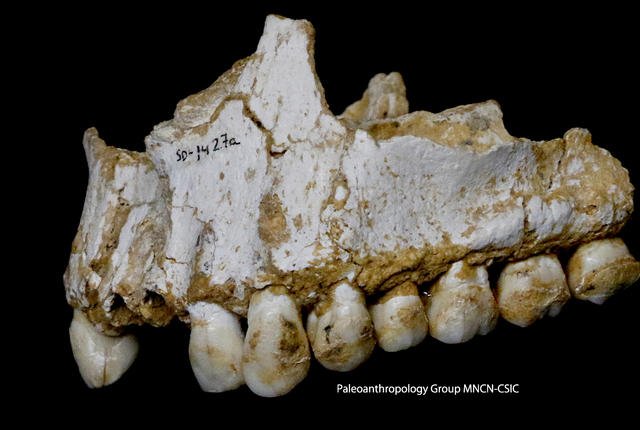
Part of a Neanderthal skull
Credit: Paleoanthropology Group MNCN-CSIC/Twitter
See the brown marks on the Neanderthal teeth above? They're dental calculus (tartar). I.e. calcium deposits formed while the former owner was alive. Preserved within the calculus is material from inside the mouth during life. DNA remains from bacteria & components of the diet. In life, the individual whose teeth are shown above had been eating wooly rhino, mouflon sheep & mushrooms.
Examination of the skull of another Neanderthal has revealed:
● dental abscess
● diet high in poplar bark – a source of salicylic acid (aspirin)
● penicillin mould
Aspirin + penicillin – sounds like a sensible treatment for a dental abscess. Does this indicate that Neanderthals had a knowledge of pharmacology? More in the podcast & transcript at:
http://www.abc.net.au/radionational/programs/scienceshow/did-neanderthals-know-about-antibiotics/8363970 / Neanderthals antibiotics Professor Alan Cooper University of Adelaide South Australian Scientist of the Year analysed calcified tartar teeth of Neanderthals tartar reveals microbiome diversity of bacteria on the teeth bacteria can be associated with vegetation eaten health Neanderthal from Spain nasty abscess nasty gastro parasite gastrointestinal parasite further analysis revealed diet high in poplar bark source of salicylic acid aspirin home remedy for pain other samples penicillin mould vegetation covered in white mould Neanderthal consciously eat the mould aware mould’s antibiotic action Neanderthal antibiotic effects of penicillin 50,000 years before it was discovered by western science Neanderthals Professor Alan Cooper Adelaide carry evidence what they had for dinner calcified bacteria teeth Neanderthal specimens examine their microbiome complete diversity of bacteria carrying around with them look at health our relationship kind of diseases shared picked up from them whole bunch of information about their diet their behaviour bacteria key findings Neanderthals very nasty dental abscess very nasty gastro parasite we picked up in his tartar calcified bacteria eating large amounts of poplar source salicylic acid aspirin willow poplar bark and the buds using home remedies for pain tartar diet penicillin mould actual fungus that makes penicillin fungus Penicillium mould relatively widespread environment by-catch that particular Neanderthal young male from Spain had four different types of plant moulds in his mouth in the diet eating moulded vegetation mountainsides of northern Spain pine forest white mould growing on the pine needles eating Neanderthals his mouth is sore dental abscess eat moulded vegetation antibiotic action speculative 50,000 years before western medicine discovered antibiotics Neanderthals history of using plants chimpanzees Richard Wrangham in Harvard selected certain leaves ate stomachs were empty had a greater effect upset chimpanzees Spain tradition ancient humans Neanderthals animals all of our ancestors hunter gatherer ancestors plant pharmacogenetics pharmacology Neanderthals from Spain were almost vegetarians diet teeth pine nuts bark mushrooms Neanderthals from Belgium on the edge of the mammoth steppe grass plain stretches all the way back through Siberia into Alaska eating rhino mouflon sheep mushroom Neanderthals big red meat eaters preying scavenging mega-fauna DNA dental calculus tartar local environment traditional Palaeolithic diet edge of the mammoth steppe vegetarian pine nut occupation northern Spain mountainous forest food adapted to the local environment Palaeolithic diet tartar thousands of years intact could analyse it perfect fossil study the microbiome important thing our lives animals controls fossilise fossilize coprolites fossilised fossilized poo faeces biological warfare bacteria and fungus bacteria coprolite tartar on your teeth constantly fossilising all the time bacterial plaque growing on your teeth covered in the calcium from your saliva fill holes in your teeth at night when you die you already have a fossilised set of bacteria sitting on your teeth nicely laid down in calcium Professor Alan Cooper University of Adelaide South Australian Scientist of the Year /
No comments:
Post a Comment